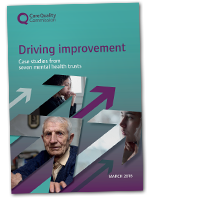What does it take to raise standards in a mental health trust? How can a trust that requires improvement become good or outstanding?

To help answer those questions we visited seven NHS mental health trusts that had achieved significant improvements in their ratings.
At each trust, we interviewed a range of people, including chief executives, medical directors, nursing directors, other clinical and managerial staff, and front line staff. We also spoke to others who knew or worked with the trust, such as local patient or voluntary groups.
Key themes
- Reaction to initial inspection report/rating
A poor rating for many trusts was a stimulus for improvement. Trusts used the reports as a springboard to make changes.
- Leadership
Trust leaders were clear that improvements had to be owned and driven by staff, but knew they needed to be visible and approachable in order for staff to feel supported.
- Governance
Good leadership and good governance go hand in hand. Most of the trusts featured made changes to their systems and processes to drive improvement and to monitor improvement.
- Culture
Cultural changes were essential to delivering improvement. One of the most valuable changes in the trusts featured was creating an environment in which staff feel able to speak up and speak out; this helped learning and improvement.
- Staff engagement and empowerment
Engaging and empowering staff at all levels was key in improving trusts. Once staff feel they have a part to play and that they are listened to and valued, improvement gathers speed.
- Involving patients/people who use services
Taking the views and experiences of patients and the public into account is vital to making improvements.
- Outward looking
Working with others in the local health and care system and voluntary sector, and recognising that real and lasting improvement depends on organisations working together was a key feature of the improving trusts.
- Relationship with CQC
Most of our trusts acknowledged an improvement in relations with CQC over time. Being able to speak to CQC staff between inspections was seen as helpful and an open relationship encouraged the sharing of concerns and discussions about solutions.
- Next on the improvement journey
Good is not enough for the featured trusts. They all see improvement as a continuous process, and this is about more than aiming for an outstanding rating.
Download the report
Driving improvement: Case studies from mental health NHS trusts
Related information:
News story: Strong leadership essential to delivering improvement in mental health hospital care
Snippet for Driving improvement report pages
Driving improvement reports
Driving improvement through technology
Driving improvement: Case studies from NHS trusts
Driving improvement: Case studies from mental health trusts
Driving improvement: Case studies from adult social care services
Driving improvement: Case studies from GP practices
Driving improvement: Case studies from independent hospitals
Driving improvement: Individuals who have made a difference
